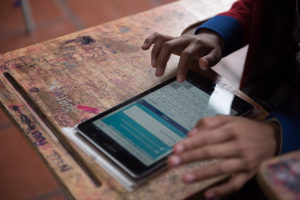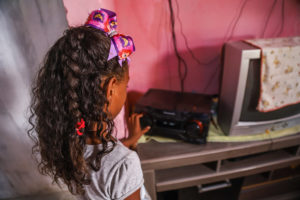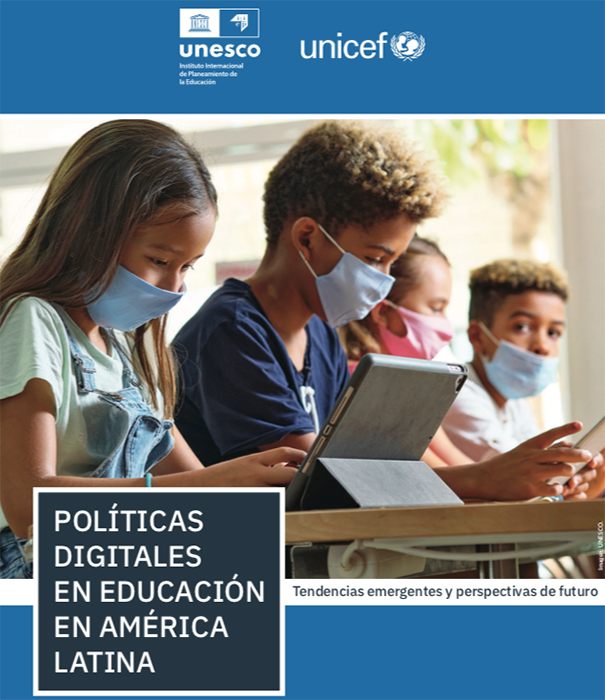The virtualisation of education: from emergency to planning
When the COVID-19 pandemic turned our societies upside down in March 2020, many sectors, such as healthcare, had long since embraced technological breakthroughs. However, education remained anchored in a rather distant past where, while technology and artificial intelligence were advancing by leaps and bounds, children were still learning with anachronistic approaches inherited from the Industrial Revolution.

Then a microscopic virus changed everything and millions of students were suddenly and unwittingly immersed in the greatest educational experiment in history. With schools closed, the incorporation of new technologies in the education sector, which until then had been incipient, isolated and disparate, became an imperative that put school systems to the test.
The crisis boosted previous efforts to incorporate digital technologies in a way that no previous public policy had achieved. But it was also an improvised impulse that responded more to an emergency solution than to a planned process aimed at making pedagogical use of technology to enrich learning.
But the pandemic also served to put education at the centre of the agenda of national and international organisations, and leapt from the pages of academic and specialist publications to the general and mass media. Are students getting the training they need? How to guarantee universal access to quality education? Can technology help universalise education or will it further widen learning gaps? Are teachers trained to incorporate technology in their classrooms? What should be their role in the possible transformation of education? How can the inertia of this improvised change and its learnings be harnessed to bring about a virtuous digital transformation of the education sector?

In this context, the study Digital policies in education in Latin America published by UNESCO and UNICEF, seeks to contribute to this debate by identifying and systematising the learning and new capacities installed in the remote education scenario in order to capitalise on these lessons learned and promote the development of digital policies that make educational models more flexible, better and more inclusive.
The study, which focuses on national policies, is based on six case studies of countries in the region: Argentina, Chile, Colombia, Costa Rica, Mexico and Uruguay.
The crisis boosted previous efforts to incorporate digital technologies in a way that no previous public policy had achieved.
El estado de la cuestión
What was observed in these case studies? We summarise it below:
- Access and connectivity gaps. The access gap to digital technologies was, throughout the region, one of the main obstacles to overcome in the context of the pandemic. Although there have been efforts to expand coverage and democratise access, the gap remains wide and deep.
- Teacher capacity building. All the countries in the study developed a wide range of initiatives aimed at accompanying and building ICT skills among teachers. The common feature of these experiences has been the focus on pedagogical needs linked to emergency remote learning. It also highlights the emergence of support networks and virtual communities of practice. The evidence indicates that, as a result of this process, the digital skills of many teachers have increased, setting a new floor for thinking about training policies in the future.
- Management of educational information for decision-making. The pandemic set in motion a number of initiatives related to education information management aimed at providing inputs for system governance and underpinning the decision-making process. In fact, digital platforms acquired a key role in relation to the recording, processing and systematisation of information. This has arguably been one of the most innovative lines of action at this stage, although progress has been limited so far.
- Transmissive practices persist, now virtualised. The virtualisation of teaching led to an increase in the volume of pedagogical experimentation. However, it is necessary to highlight that, in general terms, transmissive practices framed in the logic of direct teaching still persist, although they are now mediated by virtual environments. Technologies were unable to break the inertia of a pedagogical model that was still entrenched, even in cases where connectivity conditions were adequate.
- Public-private partnerships. The intensification of public-private partnerships was key in the search for solutions for connectivity, content production, digital platform development and teacher training, in a context of increasing budgetary constraints.
- Slowdown of ICT initiatives. The still partial and intermittent return to the classroom has been accompanied by the halting or slowing down of ICT initiatives.
And what are the lessons learned from the trends observed in these case studies? This Observatory has taken note of these lessons and has taken them on board and turned them into suggestions for policy actions.
- Without access, there is no educational inclusion. Once again, it has become clear that access policies are a necessary condition for the development of digital inclusion policies in the region.
- Turn the fragmented, incidental and experimental integration of technology in education into a coordinated and planned thrust. Until 2020, the penetration of digital technologies in education systems was generally fragmented, incidental and associated with a few specific projects, only of limited or experimental scope. The situation also showed that there are huge gaps between the policy frameworks on school integration with the digital society and their actual implementation at system level.
- Promote and strengthen new spaces for teaching collaboration. One of the great innovations that has promoted the situation of isolation has been the construction of national and transnational teaching collectives, of virtual networks of peer support and collaboration, and of cooperative production. These spaces mark a new direction in the design of peer-to-peer training strategies that should be analysed and promoted.
- Strengthen the importance of multi-sectoral partnerships for the implementation of digital policies. In looking at the management of responses, it is important to recognise the value of a valuable strategy that was driven by the health emergency: the building of multi-sectoral partnerships. Indeed, these agreements were key to the organisation of emergency responses. Public-private partnerships are particularly noteworthy, as they were empowering and enabled to cope with budgetary constraints. These collaborations look very auspicious for policy development in the medium term.
- Helping to build a state vision. Countries need to build a comprehensive and sustainable vision for digital inclusion in education that is not only aligned with education sector policies, but also with the digital transformation policies of states. This requires a consensus that can be sustained beyond changes in governmental administrations.
- Prioritise decision-making based on data intelligence. In addition to prioritising access, it is necessary to strengthen information systems to favour decision-making and to define processes of analysis and permanent circulation of results, which add value to the different users of the information and which are conceived and defined around qualitative objectives of continuous improvement of the system.
- Invest more and better. Making progress in the digital transformation of education systems requires sustained investment and this situation is particularly problematic in contexts of budgetary constraints such as those faced by all countries in the region. Funding decisions are not exclusively technical but also political. A rigorous assessment of the relationship between costs and effective uses would allow for better management of resources, which are always scarce.
We know that new technologies have great potential to expand access to quality education for every child on the planet. But to unlock that potential and avoid further deepening inequalities, it is very important to have a clear and accurate picture of the situation to enable us to devise and implement the right policies. It will require creativity, innovation, planning and investment.
The pandemic has turned out to be an extraordinary exercise in identifying digital skills needs for the 21st century. The degree of awareness of the possibilities and demands has been generalised and consensual, so this story cannot end in involution, with a return to past pedagogical and didactic models that have proved ineffective in resolving the educational gaps in Latin American countries.
If you want to know more details and have a look at the complete study, find out more here.






